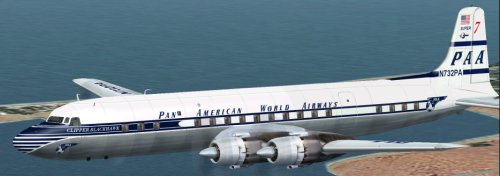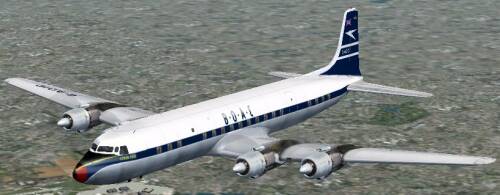
The Douglas DC-7C Seven Seas

After Lockheed introduced the L1049G "Super G" Constellation for TWA, Pan American needed an aircraft that was able to fly non-stop transatlantic services, even westbound with average winds (their current DC-7B service usually required a stop). Douglas responded by stretching the fuselage by 42 inches and, more importantly, lengthening the wings by inserting a 5 foot extension at each wing root. This gave the new DC-7C Seven Seas (in a clever pun on "7C") not only more room for fuel, but placed the engines further out on the wing, lessening the noise and vibration of the rather loud Wright R-3350 radials. More powerful engines of 3400 hp each were fitted to the DC-7C, and all these improvments stretched the range to 5635 miles, allowing non-stop routes never before possible with Douglas aircraft. The first Seven Seas service was introduced by Pan American on June 1, 1956, and a total of 121 DC-7C's were eventually delivered to the airlines. That total makes it the most numerous of the DC-7 series.
The DC-7C went on to fly non-stop routes across the US, as well as in transatlantic, transpacific, and even Great Circle routes over the North Pole. Lockheed was forced to play catch up to the DC-7C, and finally developed the L1649A Starliner, which was originally supposed to be a turboprop, but ended up with R-3350's and was slightly slower than the Seven Seas, although it had greater range. It was introduced too late for substantial orders, however, and Lockheed lost a lot of money on the project. In service, the DC-7C was not as reliable as the DC-6 series, and was the last piston-engined Douglas airliner model introduced. In fact, when the last KLM DC-7C was delivered in December 1958, the Boeing 707 was already in service, marking the end of an era. As soon as the jets were in place the airlines either converted the DC-7C's to freighters or sold them to second tier operators. Most DC-7C's did not have long lives, and virtually all have been scrapped. Until recently there were a few in fire bomber service, however, demonstrating the usefulness of a design that started during WWII with the DC-4 and culminating with the Seven Seas, a plane that finally brought virtually every spot on the globe within reach of the world's airlines via a direct routing.
High quality R-3350 DC-7 stereo sounds are available from Jon Jefferys. These are the best I've heard so far. They are designed to be used with the FS2004 slow engine startup. This package is downloaded separately; the base packs include a much smaller PropSound package. Last updated on 10/30/13. Update that reduces sound when engines are stopped. Last updated on 11/1/2013.
To repaint this model you can use the Paint kit for GMAX DC-7's. Contains layered PSD files (usable in both Photoshop and Paint Shop Pro) which allow you to place your paint scheme between the bare metal layers and the windows and doors. Makes for fast painting! Note: there are no actual painting instructions in the file; follow the detailed instructions in my Repainting Tutorial. Please read the included text file for details for each DC-7 model. Now includes opening door shapes and freight doors for the DC-7CF and DC-7F (20 MB). Description of the DC-7CF interior textures here and here. Last updated on 10/31/13.
 FS2004
Pan American World Airways DC-7C Seven Seas Base Pack.
FS2004 ONLY. Dave McQueen and I have painted up Greg Pepper's and my great GMAX Seven
Seas in the classic Pan American delivery scheme, featuring the winged world
emblem on the fuselage. This now has the new VC and opening doors too.
Of course it has FSAviator's great flight dynamics too! Now includes a
non-radar version for TAI/Madair liveries. This one was Clipper Blackhawk -
thanks again! Requires the FS2004 United DC-7
Base Pack for panel and sounds. Last modified on 3/12/23.
FS2004
Pan American World Airways DC-7C Seven Seas Base Pack.
FS2004 ONLY. Dave McQueen and I have painted up Greg Pepper's and my great GMAX Seven
Seas in the classic Pan American delivery scheme, featuring the winged world
emblem on the fuselage. This now has the new VC and opening doors too.
Of course it has FSAviator's great flight dynamics too! Now includes a
non-radar version for TAI/Madair liveries. This one was Clipper Blackhawk -
thanks again! Requires the FS2004 United DC-7
Base Pack for panel and sounds. Last modified on 3/12/23.
FSX/P3D DC-7C Base Pack. I've converted the model to FSX native format for use in FSX and P3D. This is a full package and does not need the FS2004 Base Pack above. Requires the FSX/P3D United DC-7 Base Pack for panel and sounds. Last updated on 3/12/23..
 FS2004/FSX
Scandinavian Air System DC-7C Seven Seas. While SAS used the '7C on
it's routes to the US and Asia, it's real claim to fame was to inaugurate the
"over the pole" route from Copenhagen to Tokyo, and other similar routes including
the original polar route, Copenhagen to Los Angeles. This plane, the "Guttorm
Viking" was the first to fly this very long route. This is actually a
package of the GMAX DC-7C with 4 SAS liveries, including those from the earliest
delivery to the last cargo hauler, all painted by Jens B Kristensen . Thanks!
Use the textures only - requires the Pan
American DC-7C Base Pack above and the United DC-7
Base Pack for panel and sounds. Last modified on 7/16/03.
FS2004/FSX
Scandinavian Air System DC-7C Seven Seas. While SAS used the '7C on
it's routes to the US and Asia, it's real claim to fame was to inaugurate the
"over the pole" route from Copenhagen to Tokyo, and other similar routes including
the original polar route, Copenhagen to Los Angeles. This plane, the "Guttorm
Viking" was the first to fly this very long route. This is actually a
package of the GMAX DC-7C with 4 SAS liveries, including those from the earliest
delivery to the last cargo hauler, all painted by Jens B Kristensen . Thanks!
Use the textures only - requires the Pan
American DC-7C Base Pack above and the United DC-7
Base Pack for panel and sounds. Last modified on 7/16/03.
 FS2004/FSX
British Overseas Airways DC-7C Seven Seas. Next is BOAC, which wasn't
in the habit of purchasing Douglas aircraft (in fact, these and a few DC-3's
may be their only Douglas planes!). When the Britannia encountered development
delays, BOAC needed a plane for their premier transatlantic routes. Thus,
10 DC-7C's were purchased to tide them over and flew into San Francisco from
New York, connecting with QANTAS Connies. All were named "Seven Seas".
Painted by Eric Joiner. Use the textures only - requires the Pan
American DC-7C Base Pack above and the United DC-7
Base Pack for panel and sounds. Earlier livery with white tail. Last updated on 6/11/10.
Version
by Jens Christensen (pictured) - thanks! Last modified on 4/7/04.
FS2004/FSX
British Overseas Airways DC-7C Seven Seas. Next is BOAC, which wasn't
in the habit of purchasing Douglas aircraft (in fact, these and a few DC-3's
may be their only Douglas planes!). When the Britannia encountered development
delays, BOAC needed a plane for their premier transatlantic routes. Thus,
10 DC-7C's were purchased to tide them over and flew into San Francisco from
New York, connecting with QANTAS Connies. All were named "Seven Seas".
Painted by Eric Joiner. Use the textures only - requires the Pan
American DC-7C Base Pack above and the United DC-7
Base Pack for panel and sounds. Earlier livery with white tail. Last updated on 6/11/10.
Version
by Jens Christensen (pictured) - thanks! Last modified on 4/7/04.
 FS2004/FSX
Pan American DC-7C Seven Seas. Wayne Tudor has painted the GMAX DC-7C
into the later colors of Pan American. The DC-7C allowed the airline to
introduce Great Circle service from London/Paris to Seattle in 1957. Pan
American used the DC-7C in international service until the jets arrived. Textures
only - requires the Pan American DC-7C Base Pack above
and the United DC-7Base Pack for panel and sounds. Last
updated on 2/14/05. Thanks!
FS2004/FSX
Pan American DC-7C Seven Seas. Wayne Tudor has painted the GMAX DC-7C
into the later colors of Pan American. The DC-7C allowed the airline to
introduce Great Circle service from London/Paris to Seattle in 1957. Pan
American used the DC-7C in international service until the jets arrived. Textures
only - requires the Pan American DC-7C Base Pack above
and the United DC-7Base Pack for panel and sounds. Last
updated on 2/14/05. Thanks!
 FS2004/FSX
Japan Air Lines DC-7C Seven Seas. Let's take a break from the European
Seven Seas for a moment, and feature the only Asian airline that bought the
'7C, Japan Air Lines, painted by Wayne Tudor. While others were purchasing
Connies, Japan had always been a Douglas proponent, from DC-4's right on through
to DC-10's. Japan used their Seven Seas for the long haul across the Pacific
to San Francisco and Seattle. It allowed Japan to eliminate the Wake Island
stop on the SFO run, significantly shortening the trip. Unusually, this
"City of San Francisco" (and other DC-7C's) was not named for a Japanese city
or feature. Textures only - requires the Pan
American DC-7C Base Pack above and the United DC-7
Base Pack for panel and sounds. Last updated on 2/14/05.
FS2004/FSX
Japan Air Lines DC-7C Seven Seas. Let's take a break from the European
Seven Seas for a moment, and feature the only Asian airline that bought the
'7C, Japan Air Lines, painted by Wayne Tudor. While others were purchasing
Connies, Japan had always been a Douglas proponent, from DC-4's right on through
to DC-10's. Japan used their Seven Seas for the long haul across the Pacific
to San Francisco and Seattle. It allowed Japan to eliminate the Wake Island
stop on the SFO run, significantly shortening the trip. Unusually, this
"City of San Francisco" (and other DC-7C's) was not named for a Japanese city
or feature. Textures only - requires the Pan
American DC-7C Base Pack above and the United DC-7
Base Pack for panel and sounds. Last updated on 2/14/05.
 FS2004/FSX
Mexicana DC-7C Seven Seas. Here's the DC-7C that Wayne Tudor has painted
into the Pan American-inspired colors of Mexicana, which flew them on their
international routes including service from Mexico City to the US. Enjoy!
Textures only - requires the Pan American
DC-7C Base Pack above and the United DC-7 Base Pack for panel
and sounds. Last updated on 3/22/05.
FS2004/FSX
Mexicana DC-7C Seven Seas. Here's the DC-7C that Wayne Tudor has painted
into the Pan American-inspired colors of Mexicana, which flew them on their
international routes including service from Mexico City to the US. Enjoy!
Textures only - requires the Pan American
DC-7C Base Pack above and the United DC-7 Base Pack for panel
and sounds. Last updated on 3/22/05.
 FS2004/FSX Douglas Aircraft DC-7C Seven Seas.
Dave McQueen has painted up Greg's and my DC-7C into the very interesting house
colors of DAC. This was the plane that demonstrated the DC-7C's excellent range
and reasonable economics. It qualifies for inclusion because it was built and
painted right here in Santa Monica, California. Thanks! Use the textures
only - requires the Pan American DC-7C Base Pack above
and the United DC-7 Base Pack for panel and sounds. Last
updated on 4/13/06.
FS2004/FSX Douglas Aircraft DC-7C Seven Seas.
Dave McQueen has painted up Greg's and my DC-7C into the very interesting house
colors of DAC. This was the plane that demonstrated the DC-7C's excellent range
and reasonable economics. It qualifies for inclusion because it was built and
painted right here in Santa Monica, California. Thanks! Use the textures
only - requires the Pan American DC-7C Base Pack above
and the United DC-7 Base Pack for panel and sounds. Last
updated on 4/13/06.